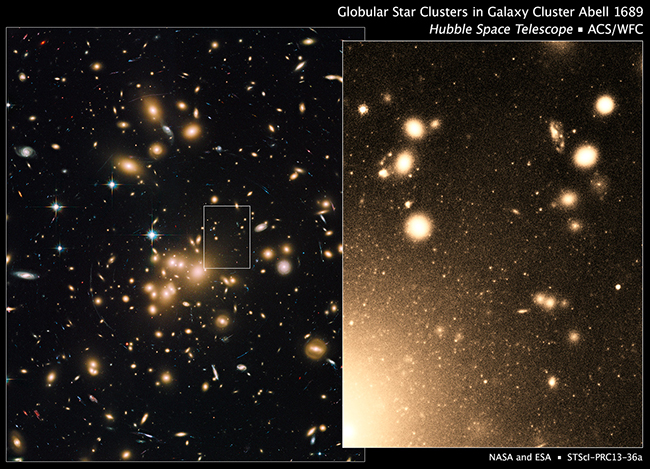
On a day which yielded another historic announcement about a spacecraft launched long ago, NASA today announced that the Hubble Space Telescope (HST) revealed the largest known group of star clusters—estimated at approximately 160,000 (10,000 visible)—in a grouping of galaxies called Abell 1689, which is 2.4 million light-years across.
In addition, an associated study revealed that most of the clusters formed near the galaxies’ center grouping, which contains scads of dark matter. As Hubble looked further away from the galaxies’ center, it observed less of these clusters—a phenomenon noted in past research. The clusters are described on HST’s NASA web page as appearing like “a blizzard of snowflakes.”
These star clusters, called globular clusters, consist of the universe’s oldest surviving stars. The “Big Bang” was theorized to have occurred 13.8 billion years ago; about 95 percent of these clusters were formed one to two billion years ago. The study of these clusters is elemental to understanding how the universe—and us—came to be. Dark matter may also provide the key into understanding how galaxies and galaxy clusters were synthesized.
A team of international astronomers used HST’s Advanced Camera for Surveys to discover these globular clusters and clues into dark matter. These camera’s images were synthesized by HST from June 12 to 21, 2002, and May 29 to July 8, 2010. The team was led by a team led by John Blakeslee of National Research Council Canada’s Herzberg Institute of Astrophysics at the Dominion Radio Astrophysical Observatory in Victoria, British Columbia.
Blakeslee said, “The globular clusters are fossils of the earliest star formation in Abell 1689, and our work shows they were very efficient in forming in the denser regions of dark matter near the center of the galaxy cluster. Our findings are consistent with studies of globular clusters in other galaxy clusters, but extend our knowledge to regions of higher dark matter density.”
When asked how the team estimated there were about 160,000 clusters, he said, “Even though we are looking deep into the cluster, we’re only seeing the brightest globular clusters, and only near the center of Abell 1689 where Hubble was pointed.”
Karla Alamo-Martinez, who is the lead author of a paper published Sept. 10 discussing the findings (the paper will also appear in the Sept. 20 edition of The Astrophysical Journal), underscored the significance of the findings by the telescope and the team. She is part the Center for Radio Astronomy and Astrophysics of the National Autonomous University of Mexico in Morelia.
“We show how the relationship between globular clusters and dark matter depends on the distance from the center of the galaxy grouping. In other words, if you know how many globular clusters are within a certain distance, we can give you an estimate of the amount of dark matter,” she related.
Deployed by one of NASA’s finest workhorses, Space Shuttle Discovery, during STS-31 in 1990, Hubble, a joint operation by NASA and the European Space Agency (ESA), continues to unveil new discoveries about our universe, giving us a deeper understanding of our cosmos. Like today’s “celebrity” Voyager 1, it will continue to earn its spot in space history.
Want to keep up-to-date with all things space? Be sure to “Like” AmericaSpace on Facebook and follow us on Twitter: @AmericaSpace



